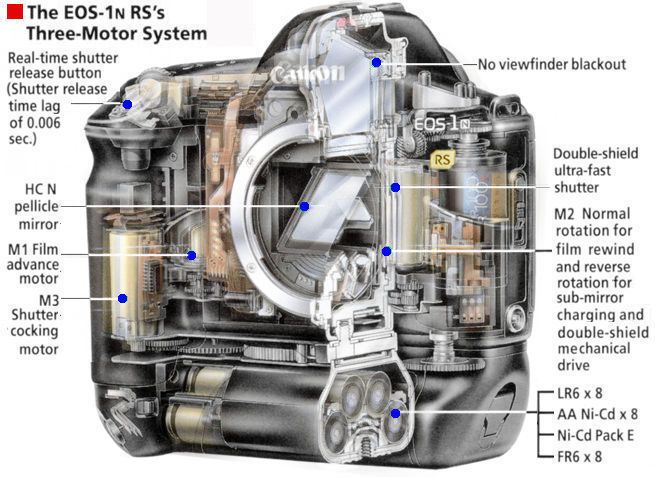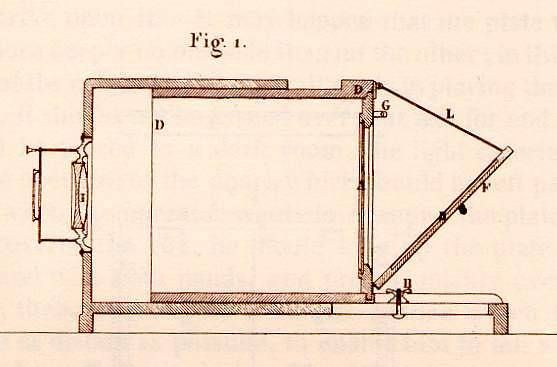Back in 1989 Canon introduced the first pellicle mirror, single lens translucent design in the Canon EOS RT. Its successor, the Canon EOS-1N, was capable of shooting up to 10 fps—on film.

http://www.mir.com.my/rb/photography/hardwares/classics/eos/EOS-1nRS/index1.htm
The problem was that the view through the optical viewfinder was very dim. The pellicle reduced light transmission by 2/3 stop, and reducing this transmission would have made the viewfinder even darker. Some period tests on Canon SLT models also suggested that a translucent pellicle robbing the exposure of 2/3 of stop of light additionally degraded image quality.
Today, it is possible to amplify the dim light signal from the pellicle with an EVF. Sony has done precisely that with their A mount DSLT design, in which the pellicle reduces transmission to the sensor by 1/2 stop. However, Sony's first implementation in a full frame model was only capable of shooting at 6 fps, which is less than what Canon's film camera SLT was capable of back in 1989, and no better than what conventional DSLRs such as the 5DIII could achieve anyway. Worse still, Sony failed to eliminate black out during shooting:
http://www.darinmcquoid.com/A99.html
The predictable result of this woeful implementation was that the Sony a99 was hardly a hit on the marketplace, and rumour has it that Sony lost money on it so badly that it might have nearly bankrupted them (they were only saved by the success of their mirrorless cameras). Sony have a bad habit of prematurely releasing grossly underdeveloped beta prototypes onto the market, and in this instance they paid dearly for it
As Sony is still licking its wounds from its self-inflicted initial failure, they are only exceedingly tentatively continuing development of their DSLT design concept. Even then with the APS-C a77II, they now achieve a 12 fps frame rate on a camera body costing less than $1000 USD. That is almost as fast as the 14 fps the Canon 1DX II manages at six times the price. Although it is virtually never spoken about, this is a far more remarkable engineering achievement than anything found in their mirrorless models over which the mindless masses in the meanwhile are going irrationally gah-gah over:
http://petapixel.com/2016/04/04/sonys-full-frame-pro-mirrorless-fatal-mistake/
A pellicle design also eliminates mirror slap and the image degradation this mechanical movement causes, something that will become increasingly desirable as sensor resolutions inch towards 120MP, and become more sensitive to such movement. It also means the elimination of an expensive and heavy mechanical moving part, resulting in a weight reduction for the body. If a film EOS camera could shoot at 10 fps back in the 1990s, one can only imagine what a more convincingly executed high-end Canon DSLT design might be capable of today
The EVF further permits real time exposure preview, including a histogram, a feature normally associated with mirrorless cameras. Some would add that current EVFs have a lag, meaning that this makes them less suitable for shooting action, but EVFs are improving. Given that a higher frame rate is intended for shooting action, this would appear to be a significant design disadvantages—at least for the time being until EVF technology catches up.
From the perspective of autofocus, a DSLT uses a dedicated AF sensor for continuous PDAF, one separate from the main image sensor. This gives it a significant advantage over mirrorless designs in its AF speed. However, in the meantime, on-sensor PDAF has been developed, such as in the dual-pixel autofocus system from Canon, where AF capabilities are built into the main image sensor. Whether hybrid on-sensor plus off-sensor PDAF would confer any advantage is unknown. Perhaps, the loss of light transmission from the translucent pellicle could be reduced to somewhat less than 1/3 stop, and the resulting reduction of PDAF performance from the dedicated AF sensor be made up with some on-sensor PDAF. That is pure speculation, however.
A new Canon digital pellicle model would have all the key advantages of mirrorless, along with all of the key advantages of a DSLR. It would as fast, or faster than a DSLR, and have the electronic viewfinder of a mirrorless for live exposure preview. The result would be a hybrid of DSLR and mirrorless design concepts. This stands in marked contrast to a professional grade DSLR-sized FF mirrorless with all the disadvantages of mirrorless and none of the advantages of a DSLR.
So it would certainly be interesting to see if Canon have ever considered revisiting their pellicle mirror SLR designs for the digital age. They have extensive experience with it, and this will help them succeed in digitalising the technology where Sony have hitherto failed—although that too may soon change. Developing a Canon DSLT would also have the advantage over starting up a full frame mirrorless system in that it would not require the expensive development of a new full frame mirrorless lens mount, as it would be able to take EF mount lenses. Nor would users have to buy new lenses to adopt the new technology as they would for a full frame mirrorless system from Canon.

http://www.mir.com.my/rb/photography/hardwares/classics/eos/EOS-1nRS/index1.htm
The problem was that the view through the optical viewfinder was very dim. The pellicle reduced light transmission by 2/3 stop, and reducing this transmission would have made the viewfinder even darker. Some period tests on Canon SLT models also suggested that a translucent pellicle robbing the exposure of 2/3 of stop of light additionally degraded image quality.
Today, it is possible to amplify the dim light signal from the pellicle with an EVF. Sony has done precisely that with their A mount DSLT design, in which the pellicle reduces transmission to the sensor by 1/2 stop. However, Sony's first implementation in a full frame model was only capable of shooting at 6 fps, which is less than what Canon's film camera SLT was capable of back in 1989, and no better than what conventional DSLRs such as the 5DIII could achieve anyway. Worse still, Sony failed to eliminate black out during shooting:
http://www.darinmcquoid.com/A99.html
The predictable result of this woeful implementation was that the Sony a99 was hardly a hit on the marketplace, and rumour has it that Sony lost money on it so badly that it might have nearly bankrupted them (they were only saved by the success of their mirrorless cameras). Sony have a bad habit of prematurely releasing grossly underdeveloped beta prototypes onto the market, and in this instance they paid dearly for it
As Sony is still licking its wounds from its self-inflicted initial failure, they are only exceedingly tentatively continuing development of their DSLT design concept. Even then with the APS-C a77II, they now achieve a 12 fps frame rate on a camera body costing less than $1000 USD. That is almost as fast as the 14 fps the Canon 1DX II manages at six times the price. Although it is virtually never spoken about, this is a far more remarkable engineering achievement than anything found in their mirrorless models over which the mindless masses in the meanwhile are going irrationally gah-gah over:
http://petapixel.com/2016/04/04/sonys-full-frame-pro-mirrorless-fatal-mistake/
A pellicle design also eliminates mirror slap and the image degradation this mechanical movement causes, something that will become increasingly desirable as sensor resolutions inch towards 120MP, and become more sensitive to such movement. It also means the elimination of an expensive and heavy mechanical moving part, resulting in a weight reduction for the body. If a film EOS camera could shoot at 10 fps back in the 1990s, one can only imagine what a more convincingly executed high-end Canon DSLT design might be capable of today
The EVF further permits real time exposure preview, including a histogram, a feature normally associated with mirrorless cameras. Some would add that current EVFs have a lag, meaning that this makes them less suitable for shooting action, but EVFs are improving. Given that a higher frame rate is intended for shooting action, this would appear to be a significant design disadvantages—at least for the time being until EVF technology catches up.
From the perspective of autofocus, a DSLT uses a dedicated AF sensor for continuous PDAF, one separate from the main image sensor. This gives it a significant advantage over mirrorless designs in its AF speed. However, in the meantime, on-sensor PDAF has been developed, such as in the dual-pixel autofocus system from Canon, where AF capabilities are built into the main image sensor. Whether hybrid on-sensor plus off-sensor PDAF would confer any advantage is unknown. Perhaps, the loss of light transmission from the translucent pellicle could be reduced to somewhat less than 1/3 stop, and the resulting reduction of PDAF performance from the dedicated AF sensor be made up with some on-sensor PDAF. That is pure speculation, however.
A new Canon digital pellicle model would have all the key advantages of mirrorless, along with all of the key advantages of a DSLR. It would as fast, or faster than a DSLR, and have the electronic viewfinder of a mirrorless for live exposure preview. The result would be a hybrid of DSLR and mirrorless design concepts. This stands in marked contrast to a professional grade DSLR-sized FF mirrorless with all the disadvantages of mirrorless and none of the advantages of a DSLR.
So it would certainly be interesting to see if Canon have ever considered revisiting their pellicle mirror SLR designs for the digital age. They have extensive experience with it, and this will help them succeed in digitalising the technology where Sony have hitherto failed—although that too may soon change. Developing a Canon DSLT would also have the advantage over starting up a full frame mirrorless system in that it would not require the expensive development of a new full frame mirrorless lens mount, as it would be able to take EF mount lenses. Nor would users have to buy new lenses to adopt the new technology as they would for a full frame mirrorless system from Canon.

